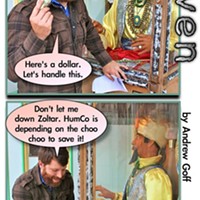Some years back, when I called the North-South railroad and its backers Idealistic Dreamers Involved in Our Transportation System (IDIOTS for brevity), you might have thought that I was anti-railroad. Such is not the case. A railroad would do wonders for our local economy. What I am against is using public funds on an endeavor like that one, which had two studies done, each showing the line would lose public money! When the East-West (EW) proposal first surfaced at the Eureka City Council over a year ago, I went to participate in the discussion. Bill Barnum caught me off-guard when he pitched the proposal, and he stated that this was a project to be undertaken by the private sector. I have no qualms with what people want to do with their own money, so I told the council a railroad would be nice — but keep a tight hold on your tax dollars.
Something changed! Now the EW proponents want a $300,000 Caltrans grant to do a feasibility study. That is not private financing; that is our tax money. This process, now that public funds are being sought, rankles me on a couple of fronts: First, why are public monies being sought to find out if some Rich Opportunistic Businessman (ROB for short) can make money? The ROB should use his own money. A prime example of this arose in 1982, when Exxon was considering Humboldt Bay as a location to build oil platforms for the Santa Barbara Channel. The oil company paid the county about $2 million to do a lot of the work required. It did not ask the public to check things out and let Exxon know if it will work. In the end, it had the platforms constructed in Korea.
Second, before anyone invests even seed money, it is prudent for either the public or private sector to prepare a quickie pre-feasibility study to see if this project even has a chance of succeeding. I have sat through one of the presentations asking for people to support an expensive feasibility study. What will be hauled, what route will you take, what will it cost .... the answer is the feasibility study will tell us. Currently all we have is a line on a map and a request for money. We have been told it will not be containers or coal as a cargo, but once a railroad is in place I don't think anyone but the ROB has a say in what is hauled. You definitely do not want to build it and hope they will come.
Not seeing a pre-feasibility study from the proponents ( I can't even get a return call from the chairman and vice-chairman of the East-West committee to find out when its next meeting is going to occur in this transparent public process), I phoned a friend with 40 years' experience in giant port/rail projects, and he roughed one out. The line is 130 miles long, at a track cost of $1,000 per foot. We need additional money for environmental documents, earthwork, drainage, bridges, ample sidings for two-way rail traffic, signals and right of way acquisition; so we are using $3,000 per foot for the main line. In round numbers that is $2 billion. We still need port development, locomotives, design, permits, and because we are early in the project, a hefty contingency fund. So we are looking at $3 billion to get this running.
With the limitations of our port, it could handle an estimated 50 million tons per year of commodities if freight and ships were available 100 percent of the time. A rail car holds about 100 tons. That means we could see 500,000 train cars per year, one way. That equates to 1,370 cars per day, one way. If we convert to going in both directions and estimate 100-car trains, we have in excess of a 1.5 mile train at each street crossing every hour every day. At this point my expert started using rules of thumb for private financing and indicated banks would allow seven years of financing, i.e., would require repayment at the rate of $500 million per year. (The short repayment period is due to the proposed new venture having no collateral; either a large railroad company or a government body's tax base has the collateral for a 30-year loan or bond.) That means the train operator would have to add a fee of $10 per ton, or $1,000 per rail car, over and above the charges for normal operations and profit. That would put hauling costs 10 times higher than those on alternate routes that my friend is familiar with — or five times higher if there is a backhaul commodity. If the ROB gets 30-year financing it still appears unworkable.
I have put my numbers out here for the ROB and IDIOTS to scoff at, but I have at least made something public so we can discuss this rather than pursuing a dream that may not be attainable. Poke holes in this; it is a starting point. I hope you can, because a train would be nice. But government agencies should not be spending money or underwriting loans on this; nor should anyone else until we see some numbers from the ROB.
John Murray, a registered civil engineer, is a former public works director and a former county administrative officer for Humboldt County.

Comments (7)
Showing 1-7 of 7